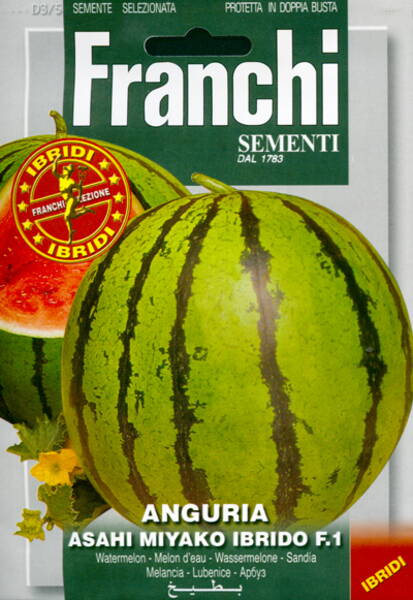Increased cold resistance.
Early (70-80 days from germination) hybrid. Plant with vigorous growth. Fruit is round, striped, medium-skinned, weighing 7-8 kg, with dark red flesh. Sweet.
Shelf life after harvesting 45-65 days + excellent transportability.
An obvious advantage of this hybrid from the Japanese company "Sakata" is also resistance to such diseases of melon crops as: fusarium and anthracnose.
Agrotechnics.
Grows well on sandy and sandy loam soils. Excessively wet soils are not suitable.
The planting site should be slightly elevated, well warmed and illuminated, protected from the winds.
In the same place, you can plant it no earlier than after 4 years. Sowing is done when the soil warms up to a depth of 8-10 cm to +15°C.
Before sowing, the seeds are treated in a solution of potassium permanganate, then washed with clean water.
In the case of seedling cultivation, the seedlings are planted when the threat of frost has passed, at the age of 3-4 true leaves.
In open ground, watermelon is planted according to the scheme 140x100 cm, in greenhouses - 70x70 cm using trellises.
1.0 g = 10-20 seeds.
* Perhaps, it is unlikely that there is a person who will say that he does not like watermelons ...
This giant berry has become to everyone's taste.
In the season when the harvest is ripening, many even use a watermelon diet to cleanse the kidneys and urinary tract, which is really effective.
But few people know that this fruit has other healing properties. For example, it is rich in iron, and therefore helps with anemia.
The increased content of easily digestible sugars makes it useful for diabetes.
For the treatment of liver and gallbladder diseases, including cirrhosis, Botkin's disease, atherosclerosis, hypertension, gout, gastritis, constipation, arrhythmia,
coronary insufficiency, tonsillitis, obesity and various intoxications, it is recommended to include 2-2.5 kg of fresh watermelon pulp in the daily diet.
For general cleansing of the body, in the absence of contraindications, watermelon fasting is used, when only watermelons and rye bread are consumed for 3-4 days.
Intensive urine excretion during these days flushes the kidneys and urinary tract, removing grains of sand and small stones.
Watermelon has medicinal properties not only in its pulp, but also in its seeds and rind. They can be stored for future use and used for the same diseases as the pulp, in the form of decoctions and infusions.
So, for gastritis, 100 g of dry rinds should be poured with 0.5 liters of boiling water and infused until completely cooled. It is better to do this in a thermos.
Adults with an average weight of 70-75 kg are recommended to take 100-125 ml of infusion 4-6 times a day. Reduce the dosage for children in proportion to the child's weight.
For cholelithiasis and to cleanse the bile ducts, pour 150-170 g of dry rinds with a liter of boiling water, put on low heat and boil for 25-30 minutes.
Take 200 ml of the decoction before meals 3-5 times a day. Consumption of watermelon pulp in large quantities is contraindicated in cases of renal failure, exacerbation of gastric ulcer, duodenal ulcer.












